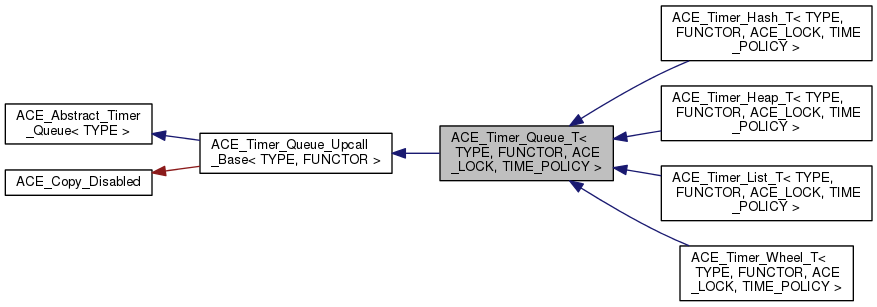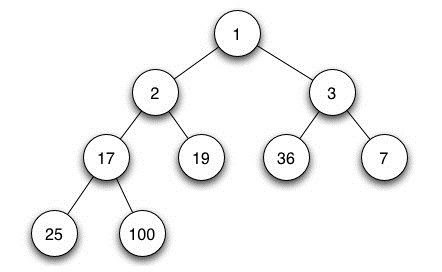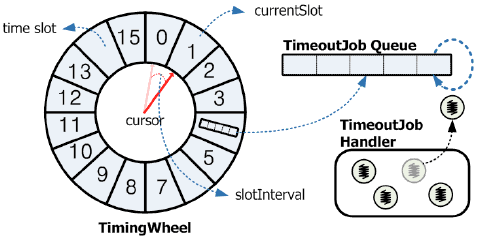本章目录
5. 定时器管理¶
5.1. 定时器类继承图¶

其中 ACE_Abstract_Timer_Queue 类为所有定时器队列的基类,提供一个统一的接口,而不管加锁策略、回调机制、内部实现。该类的主要目的是为Reactor实现了一个统一的接口类,从而是Reactor无须了解定时器队列的内部实现机制。 ACE_Timer_Queue_T<TYPE, FUNCTOR, ACE_LOCK, TIME_POLICY> 为定时器队列提供了公共的接口,从该类派生的类包括 ACE_Timer_Hash_T, ACE_Timer_Heap_T , ACE_Timer_List_T, ACE_Timer_Wheel_T 4中类型的时间队列的实现。本例中主要分析 ACE_Timer_Heap_T 类的主要数据结构和实现机制。
ACE_Timer_Queue_T 类定义原型
1 2 | template <class TYPE,class FUNCTOR,class ACE_LOCK, typename TIME_POLICY=ACE_Default_Time_Policy>
class ACE_Timer_Queue_T : public ACE_Timer_Queue_Upcall_Base<TYPE,FUNCTOR>
|
5.3. 定时器的数据结构¶
ACE_Timer_Queue_T 类成员变量
1 2 3 4 5 6 7 8 9 10 11 12 13 14 15 16 17 18 19 20 | /// Synchronization variable for ACE_Timer_Queue.
/// @note The right name would be lock_, but HP/C++ will choke on that!
ACE_LOCK mutex_;
/// Class that implements a free list
ACE_Free_List<ACE_Timer_Node_T<TYPE> > *free_list_;
/// The policy to return the current time of day
TIME_POLICY time_policy_;
/// Flag to delete only if the class created the <free_list_>
bool const delete_free_list_;
private:
/// Returned by <calculate_timeout>.
ACE_Time_Value timeout_;
/// Adjusts for timer skew in various clocks.
ACE_Time_Value timer_skew_;
|
5.3.1. Heap Timer基础知识¶
min-heap,就是 child node value 一定小于 parent node value 的 binary-tree。因此,获取 min value,只需要 pop root node 即可。

在ACE_Time_Heap类中,每个节点结构如下:
1 2 3 4 5 6 7 | ACE_Event_Handler * type_; // 时间处理的回调类
const void *act_; // 异步完成的token
ACE_Time_Value timer_value_; // 要超时的时间值
ACE_Time_Value interval_; // 周期定时器的周期值
ACE_Timer_Node_T<TYPE> *prev_; // 前一个节点
ACE_Timer_Node_T<TYPE> *next_; // 后一个节点
long timer_id_; // 定时器的id,主要用于取消
|
5.4. 定时器与Select_Reactor的分发集成¶
ace/Select_Reactor_T.cpp dispatch 函数中调用 dispatch_timer_handlers 函数处理定时器队列。
Select_Reactor_T.cpp dispatch_timer_handlers 函数
1 2 3 4 5 6 7 8 | template <class ACE_SELECT_REACTOR_TOKEN> int
ACE_Select_Reactor_T<ACE_SELECT_REACTOR_TOKEN>::dispatch_timer_handlers
(int &number_of_handlers_dispatched)
{
number_of_handlers_dispatched += this->timer_queue_->expire ();
return 0;
}
|
5.4.1. 定时器队列的 expire 函数¶
Timer_Queue_T.inl expire 函数
1 2 3 4 5 6 7 8 | template <class TYPE, class FUNCTOR, class ACE_LOCK, typename TIME_POLICY> ACE_INLINE int
ACE_Timer_Queue_T<TYPE, FUNCTOR, ACE_LOCK, TIME_POLICY>::expire (void)
{
if (!this->is_empty ())
return this->expire (this->gettimeofday_static () + timer_skew_);
else
return 0;
}
|
Timer_Queue_T.cpp expire 函数
1 2 3 4 5 6 7 8 9 10 11 12 13 14 15 16 17 18 19 20 21 22 23 24 25 26 27 28 29 30 31 32 33 34 35 36 37 38 39 | // Run the <handle_timeout> method for all Timers whose values are <=
// <cur_time>.
template <class TYPE, class FUNCTOR, class ACE_LOCK, typename TIME_POLICY> int
ACE_Timer_Queue_T<TYPE, FUNCTOR, ACE_LOCK, TIME_POLICY>::expire (const ACE_Time_Value &cur_time)
{
ACE_TRACE ("ACE_Timer_Queue_T::expire");
ACE_MT (ACE_GUARD_RETURN (ACE_LOCK, ace_mon, this->mutex_, -1));
// Keep looping while there are timers remaining and the earliest
// timer is <= the <cur_time> passed in to the method.
if (this->is_empty ())
return 0;
int number_of_timers_expired = 0;
int result = 0;
ACE_Timer_Node_Dispatch_Info_T<TYPE> info;
while ((result = this->dispatch_info_i (cur_time, info)) != 0)
{
ACE_MT (ACE_Reverse_Lock<ACE_LOCK> rev_lk(this->mutex_));
ACE_MT (ACE_GUARD_RETURN (ACE_Reverse_Lock<ACE_LOCK>, rmon, rev_lk, -1));
const void *upcall_act = 0;
this->preinvoke (info, cur_time, upcall_act);
this->upcall (info, cur_time);
this->postinvoke (info, cur_time, upcall_act);
++number_of_timers_expired;
}
ACE_UNUSED_ARG (result);
return number_of_timers_expired;
}
|
其中 29行 为调用该超时节点的 handle_timeout 函数的包装。
5.4.2. 定时器队列的 dispatch_info_i 函数¶
Timer_Queue_T.cpp dispatch_info_i 函数
1 2 3 4 5 6 7 8 9 10 11 12 13 14 15 16 17 18 19 20 21 22 23 24 25 26 27 28 29 30 31 32 33 34 35 36 37 38 39 40 | template <class TYPE, class FUNCTOR, class ACE_LOCK, typename TIME_POLICY> int
ACE_Timer_Queue_T<TYPE, FUNCTOR, ACE_LOCK, TIME_POLICY>::dispatch_info_i (const ACE_Time_Value &cur_time,
ACE_Timer_Node_Dispatch_Info_T<TYPE> &info)
{
ACE_TRACE ("ACE_Timer_Queue_T::dispatch_info_i");
if (this->is_empty ())
return 0;
ACE_Timer_Node_T<TYPE> *expired = 0;
if (this->earliest_time () <= cur_time)
{
expired = this->remove_first ();
// Get the dispatch info
expired->get_dispatch_info (info);
// Check if this is an interval timer.
if (expired->get_interval () > ACE_Time_Value::zero)
{
// Make sure that we skip past values that have already
// "expired".
this->recompute_next_abs_interval_time (expired, cur_time);
// Since this is an interval timer, we need to reschedule
// it.
this->reschedule (expired);
}
else
{
// Call the factory method to free up the node.
this->free_node (expired);
}
return 1;
}
return 0;
}
|
5.4.3. 定时器队列的 upcall 函数¶
Timer_Queue_T.inl upcall 函数
1 2 3 4 5 6 7 8 9 10 | template <class TYPE, class FUNCTOR, class ACE_LOCK, typename TIME_POLICY> ACE_INLINE void
ACE_Timer_Queue_T<TYPE, FUNCTOR, ACE_LOCK, TIME_POLICY>::upcall (ACE_Timer_Node_Dispatch_Info_T<TYPE> &info,
const ACE_Time_Value &cur_time)
{
this->upcall_functor ().timeout (*this,
info.type_,
info.act_,
info.recurring_timer_,
cur_time);
}
|
其中 14行获取最小超时时间节点,行17获取超时节点的相关信息,20-28 行为处理周期定时器。
5.5. 定时器注册¶
5.5.1. schedule 函数¶
ACE_Timer_Queue_T schedule 函数
1 2 3 4 5 6 7 8 9 10 11 12 13 14 15 16 17 18 19 20 21 22 23 24 25 26 27 | template <class TYPE, class FUNCTOR, class ACE_LOCK, typename TIME_POLICY> long
ACE_Timer_Queue_T<TYPE, FUNCTOR, ACE_LOCK, TIME_POLICY>::schedule (const TYPE &type,
const void *act,
const ACE_Time_Value &future_time,
const ACE_Time_Value &interval)
{
ACE_MT (ACE_GUARD_RETURN (ACE_LOCK, ace_mon, this->mutex_, -1));
// Schedule the timer.
long const result =
this->schedule_i (type,
act,
future_time,
interval);
// Return on failure.
if (result == -1)
return result;
// Inform upcall functor of successful registration.
this->upcall_functor ().registration (*this,
type,
act);
// Return result;
return result;
}
|
5.5.2. schedule_i 函数¶
schedule_i 函数在其继承类实现,本例以 ACE_Timer_Heap_T 类为例分析。
ACE_Timer_Heap 的定义
1 2 3 4 | typedef ACE_Timer_Heap_T<ACE_Event_Handler *,
ACE_Event_Handler_Handle_Timeout_Upcall,
ACE_SYNCH_RECURSIVE_MUTEX>
ACE_Timer_Heap;
|
Timer_Heap_T.cpp schedule_i 函数
1 2 3 4 5 6 7 8 9 10 11 12 13 14 15 16 17 18 19 20 21 22 23 24 25 26 27 28 29 30 31 32 33 34 | template <class TYPE, class FUNCTOR, class ACE_LOCK, typename TIME_POLICY>
long
ACE_Timer_Heap_T<TYPE, FUNCTOR, ACE_LOCK, TIME_POLICY>::schedule_i (
const TYPE &type,
const void *act,
const ACE_Time_Value &future_time,
const ACE_Time_Value &interval)
{
ACE_TRACE ("ACE_Timer_Heap_T::schedule_i");
if ((this->cur_size_ + this->cur_limbo_) < this->max_size_)
{
// Obtain the next unique sequence number.
long const timer_id = this->timer_id ();
// Obtain the memory to the new node.
ACE_Timer_Node_T<TYPE> *temp = 0;
ACE_ALLOCATOR_RETURN (temp,
this->alloc_node (),
-1);
temp->set (type,
act,
future_time,
interval,
0,
timer_id);
this->insert (temp);
return timer_id;
}
else
return -1;
}
|
分配的节点类型为: ACE_Timer_Node_T<TYPE>,然后设置相关信息,调用 insert 函数插入。
Timer_Queue_Iterator.h ACE_Timer_Node_T 类成员变量
1 2 3 4 5 6 7 8 9 10 11 12 13 14 15 16 17 18 19 20 21 | /// Type of object stored in the Queue
TYPE type_;
/// Asynchronous completion token associated with the timer.
const void *act_;
/// Time until the timer expires.
ACE_Time_Value timer_value_;
/// If this is a periodic timer this holds the time until the next
/// timeout.
ACE_Time_Value interval_;
/// Pointer to previous timer.
ACE_Timer_Node_T<TYPE> *prev_;
/// Pointer to next timer.
ACE_Timer_Node_T<TYPE> *next_;
/// Id of this timer (used to cancel timers before they expire).
long timer_id_;
|
5.5.3. insert 函数¶
ACE_Timer_Heap_T.cpp insert 函数
1 2 3 4 5 6 7 8 9 10 11 12 13 | template <class TYPE, class FUNCTOR, class ACE_LOCK, typename TIME_POLICY>
void
ACE_Timer_Heap_T<TYPE, FUNCTOR, ACE_LOCK, TIME_POLICY>::insert (
ACE_Timer_Node_T<TYPE> *new_node)
{
if (this->cur_size_ + this->cur_limbo_ + 2 >= this->max_size_)
this->grow_heap ();
this->reheap_up (new_node,
this->cur_size_,
ACE_HEAP_PARENT (this->cur_size_));
this->cur_size_++;
}
|
5.5.4. reheap_up 函数¶
ACE_Timer_Heap_T.cpp reheap_up 函数
1 2 3 4 5 6 7 8 9 10 11 12 13 14 15 16 17 18 19 20 21 22 23 24 25 26 27 28 29 | template <class TYPE, class FUNCTOR, class ACE_LOCK, typename TIME_POLICY>
void
ACE_Timer_Heap_T<TYPE, FUNCTOR, ACE_LOCK, TIME_POLICY>::reheap_up (
ACE_Timer_Node_T<TYPE> *moved_node,
size_t slot,
size_t parent)
{
// Restore the heap property after an insertion.
while (slot > 0)
{
// If the parent node is greater than the <moved_node> we need
// to copy it down.
if (moved_node->get_timer_value ()
< this->heap_[parent]->get_timer_value ())
{
this->copy (slot, this->heap_[parent]);
slot = parent;
parent = ACE_HEAP_PARENT (slot);
}
else
break;
}
// Insert the new node into its proper resting place in the heap and
// update the corresponding slot in the parallel <timer_ids> array.
this->copy (slot,
moved_node);
}
|
Timer_Heap_T.h heap_ 变量定义
1 2 3 4 5 6 7 | /**
* Current contents of the Heap, which is organized as a "heap" of
* ACE_Timer_Node *'s. In this context, a heap is a "partially
* ordered, almost complete" binary tree, which is stored in an
* array.
*/
ACE_Timer_Node_T<TYPE> **heap_;
|
5.5.5. upcall_functor registration函数¶
Timer_Queue_T.h upcall_functor ().registration 成员变量
1 | FUNCTOR *upcall_functor_;
|
根据 schedule_i 函数 章节可知 FUNCTOR 定位对象 ACE_Event_Handler_Handle_Timeout_Upcall。
Timer_Queue_T.h upcall_functor ().registration 成员变量
1 2 3 4 5 6 7 8 9 | ACE_INLINE int
ACE_Event_Handler_Handle_Timeout_Upcall::
registration (ACE_Timer_Queue &,
ACE_Event_Handler *event_handler,
const void *)
{
event_handler->add_reference ();
return 0;
}
|
upcall_functor ().registration 仅仅对 ACE_Event_Handler *event_handler 对象维护了引用计数的功能,无其他具体功能实现。
5.6. 定时器取消¶
ACE_Timer_Heap_T.cpp cancel 函数
1 2 3 4 5 6 7 8 9 10 11 12 13 14 15 16 17 18 19 20 21 22 23 24 25 26 27 28 29 30 31 32 33 34 35 36 37 38 39 40 41 42 43 44 45 46 47 48 49 50 51 52 53 54 55 56 57 | // Locate and remove the single timer with a value of @a timer_id from
// the timer queue.
template <class TYPE, class FUNCTOR, class ACE_LOCK, typename TIME_POLICY>
int
ACE_Timer_Heap_T<TYPE, FUNCTOR, ACE_LOCK, TIME_POLICY>::cancel (long timer_id,
const void **act,
int dont_call)
{
ACE_TRACE ("ACE_Timer_Heap_T::cancel");
ACE_MT (ACE_GUARD_RETURN (ACE_LOCK, ace_mon, this->mutex_, -1));
// Locate the ACE_Timer_Node that corresponds to the timer_id.
// Check to see if the timer_id is out of range
if (timer_id < 0
|| (size_t) timer_id > this->max_size_)
return 0;
ssize_t timer_node_slot = this->timer_ids_[timer_id];
// Check to see if timer_id is still valid.
if (timer_node_slot < 0)
return 0;
if (timer_id != this->heap_[timer_node_slot]->get_timer_id ())
{
ACE_ASSERT (timer_id == this->heap_[timer_node_slot]->get_timer_id ());
return 0;
}
else
{
ACE_Timer_Node_T<TYPE> *temp =
this->remove (timer_node_slot);
// Call the close hooks.
int cookie = 0;
// cancel_type() called once per <type>.
this->upcall_functor ().cancel_type (*this,
temp->get_type (),
dont_call,
cookie);
// cancel_timer() called once per <timer>.
this->upcall_functor ().cancel_timer (*this,
temp->get_type (),
dont_call,
cookie);
if (act != 0)
*act = temp->get_act ();
this->free_node (temp);
return 1;
}
}
|
5.7. 定时器队列注意事项¶
5.7.1. ACE时间源¶
- ACE_OS::gettimeofday() 返回 ACE_Timer_Value 的静态方法。
- ACE_High_Res_Timer::gettimeofday, 返回“OS特有的高精度定时器的值”的静态方法,并且会将该值转化成 ACE_Timer_Value 单位。该定时器常常以系统CPU启动的“嘀嗒”数,而不是以实际的挂钟时间为基础。可以避免系统时间调整对于定时器的影响。
5.7.2. 实时线程定时器¶
对于实时性要求高的定时器,可以采用 ACE_Thread_Timer_Queue_Adapter 来实现,该类启动一个单独线程来进行定时器触发。具体使用样例可以参见:ace\examples\timer_queue\Thread_Timer_Queue_Test.cpp。
5.8. 各种定时器队列对比¶
| 名称 | 描述 |
|---|---|
| ACE_Timer_Heap | 数组中实现部分有序,几乎完整的二叉树。 一般和最坏O(lgn)。 |
| ACE_Timer_Wheel | 使用含有循环缓冲区的timing wheel。 一般情况下以O(1)时间调度,取消和分配定时器。最坏需要O(n)。 |
| ACE_Timer_Hash | 使用哈希表来管理队列。 一般情况下以O(1)时间调度,取消和分配定时器。最坏需要O(n)。 |
| ACE_Timer_List | 绝对定时器链表,并按照递增的最后期限排序。 一般情况下和最坏情况下性能都是 O(n),但是使用内存最少。 |

